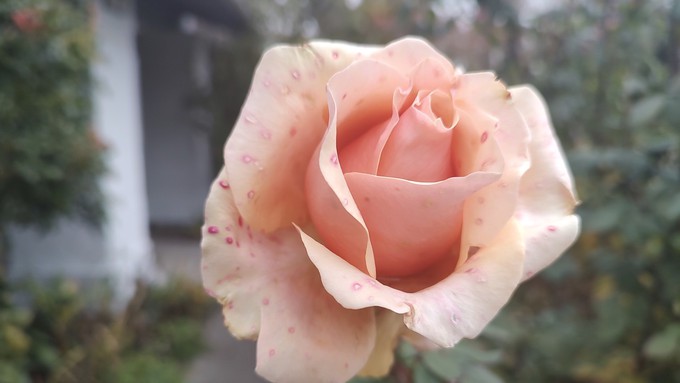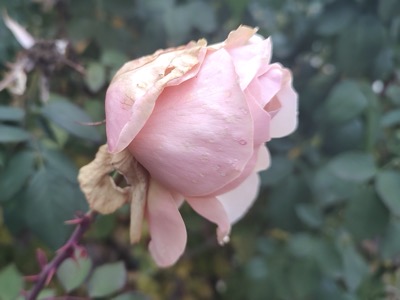
Botrytis outbreak on roses, poinsettias follows chilly, damp weather

This Marilyn Monroe rose is showing early signs of botrytis: The red spots are the symptoms. Debbie Arrington
Sacramento experienced record cold weather this past weekend and thick damp fog that seemed to just hang around.
How will this combination of cold and damp affect our gardens? A rapid shutdown to dormancy. Any fall foliage clinging to branches is dropping now.

This weather also kicks some fungal diseases into high gear. My roses saw a massive attack of botrytis – gray mold – and it’s not pretty.
According to the National Weather Service, downtown Sacramento recorded lows of 32 degrees on Dec. 17 and 18 – records for both dates. With relentless fog, Sunday (Dec. 18) was the coldest day in downtown Sacramento since January 2001; the high topped out at 42.
The fog is linked to all our ground moisture, thanks to recent rains. Lack of wind and sun keeps the fog trapped close to the ground. And that fog creates ideal conditions for gray mold.
Gray mold – which actually looks more tan or brown on the rosebud – needs moisture for growth in plant tissues, particularly tender flower petals. To prevent outbreaks, keep flower buds dry. That’s all but impossible on damp, foggy days.
Thanks to dry and warm fall weather, I had dozens of rose buds in my garden and was hoping to make some Christmas bouquets. But after so much fog and frosty nights, I’ll have few if any roses for my holiday table.
Gray mold starts out looking like pink measles or brownish water spots on light-colored flowers. Those brown spots rapidly grow until the fungus consumes the whole petal. The flower never fully opens.
Another victim to gray mold this season: Poinsettias. If left outside, they turn to mush.
Gray mold also attacks African violet, asters, begonia, carnation, chrysanthemum, cyclamen, cymbidium, gerbera, geranium, gladiolus, hydrangea, marigolds, orchids, petunia, primrose, ranunculus, snapdragon, zinnias and many other garden favorites.
According to UC Integrated Pest Management program, the best control of gray mold is “good sanitation.” Clip off infected blooms, put them in a plastic bag and dispose of them in the trash. Do not compost them; that just recycles the spores back into the garden. Pick up fallen blooms and petals around the bush and dispose of them, too.
(Since this is already pruning time, I’ll remove those infected blooms in a pass through my garden before I tackle pruning the canes.)
After pruning, rake out old mulch and fallen foliage. (This contains other fungal spores, too, for powdery mildew, rust, black spot and other rose diseases.) Then, dispose of that old mulch and replace it with fresh mulch.
For more information on gray mold, check out these pest notes from UC IPM: http://ipm.ucanr.edu/PMG/r280100511.html
Comments
0 comments have been posted.Sacramento Digs Gardening to your inbox.
Food in My Back Yard Series
May 6: Maintain soil moisture with mulch for garden success
April 29: What's (already) wrong with my tomato plants?
April 22: Should you stock up on fertilizer? (Yes!)
April 15: Grow culinary herbs in containers
April 8: When to plant summer vegetables
April 1: Don't be fooled by these garden myths
March 25: Fertilizer tips: How to 'feed' your vegetables for healthy growth
March 18: Time to give vegetable seedlings some more space
March 11: Ways to win the fight against weeds
March 4: Potatoes from the garden
Feb. 25: Plant a fruit tree now -- for later
Feb. 18: How to squeeze more food into less space
Feb. 11: When to plant? Consider staggering your transplants
Feb. 4: Starting in seed starting
Sites We Like
Garden Checklist for week of May 11
Make the most of the lower temperatures early in the week. We’ll be back in the 80s by Thursday.
* Plant, plant, plant! It’s prime planting season in the Sacramento area. Time to set out those tomato transplants along with peppers and eggplants. Pinch off any flowers on new transplants to make them concentrate on establishing roots instead of setting premature fruit.
* Direct-seed melons, cucumbers, summer squash, corn, radishes, pumpkins and annual herbs such as basil.
* Harvest cabbage, lettuce, peas and green onions.
* In the flower garden, direct-seed sunflowers, cosmos, salvia, zinnias, marigolds, celosia and asters. (You also can transplant seedlings for many of the same flowers.)
* Plant dahlia tubers.
* Transplant petunias, marigolds and perennial flowers such as astilbe, columbine, coneflowers, coreopsis, dahlias, rudbeckia and verbena.
* Keep an eye out for slugs, snails, earwigs and aphids that want to dine on tender new growth.
* Feed summer bloomers with a balanced fertilizer.
* For continued bloom, cut off spent flowers on roses as well as other flowering plants.
* Add mulch to the garden to maintain moisture. Mulch also cuts down on weeds. But don’t let it mound around the stems or trunks of trees or shrubs. Leave about a 6-inch-to-1-foot circle to avoid crown rot or other problems.
* Remember to weed! Pull those nasties before they set seed.
* Water early in the day and keep seedlings evenly moist.